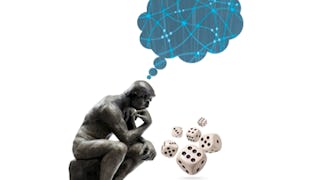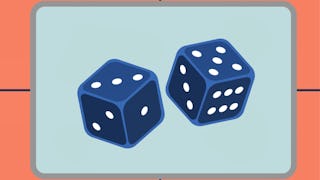Filter by
SubjectRequired
LanguageRequired
The language used throughout the course, in both instruction and assessments.
Learning ProductRequired
LevelRequired
DurationRequired
SkillsRequired
SubtitlesRequired
EducatorRequired
Explore the Probabilistic Graphical Models Course Catalog

Stanford University
Skills you'll gain: Bayesian Network, Applied Machine Learning, Graph Theory, Machine Learning Algorithms, Probability Distribution, Statistical Modeling, Bayesian Statistics, Markov Model, Decision Support Systems, Machine Learning, Probability & Statistics, Network Analysis, Statistical Inference, Sampling (Statistics), Statistical Methods, Natural Language Processing, Algorithms, Computational Thinking

Stanford University
Skills you'll gain: Bayesian Network, Bayesian Statistics, Statistical Inference, Markov Model, Graph Theory, Sampling (Statistics), Applied Machine Learning, Statistical Methods, Probability & Statistics, Algorithms, Probability Distribution, Machine Learning Algorithms, Computational Thinking

Stanford University
Skills you'll gain: Bayesian Network, Graph Theory, Probability Distribution, Statistical Modeling, Markov Model, Decision Support Systems, Probability & Statistics, Network Analysis, Applied Machine Learning, Natural Language Processing

Stanford University
Skills you'll gain: Bayesian Network, Applied Machine Learning, Machine Learning Algorithms, Markov Model, Machine Learning, Statistical Modeling, Network Analysis, Probability Distribution, Statistical Methods, Probability & Statistics, Algorithms

Skills you'll gain: Large Language Modeling, Artificial Intelligence, Generative AI, Data Ethics, Artificial Intelligence and Machine Learning (AI/ML), Applied Machine Learning, Deep Learning, Artificial Neural Networks, Governance, Prompt Engineering, Machine Learning, Automation, Digital Transformation, Business Transformation, Business Technologies, Ethical Standards And Conduct, Computer Vision, Emerging Technologies, Natural Language Processing

University of California, Santa Cruz
Skills you'll gain: Time Series Analysis and Forecasting, Bayesian Statistics, R Programming, Forecasting, Statistical Inference, Statistical Modeling, Technical Communication, Data Analysis, Probability, Statistical Machine Learning, Statistical Methods, Statistical Analysis, Advanced Analytics, Mathematical Modeling, Microsoft Excel, Markov Model, Probability Distribution, Probability & Statistics, Unsupervised Learning, Regression Analysis
What brings you to Coursera today?

University of Pennsylvania
Skills you'll gain: Risk Modeling, Financial Statements, Probability Distribution, Mathematical Modeling, Statistical Modeling, Portfolio Management, Regression Analysis, Business Modeling, Financial Modeling, Strategic Decision-Making, Risk Management, Presentations, Decision Making, Data Visualization, Microsoft PowerPoint, Predictive Modeling, Investment Management, Data-Driven Decision-Making, Spreadsheet Software, Google Sheets

University of California, Santa Cruz
Skills you'll gain: Bayesian Statistics, Statistical Inference, Data Analysis, Probability, Statistical Modeling, Statistical Analysis, Microsoft Excel, Probability Distribution, R Programming, Regression Analysis

University of Pennsylvania
Skills you'll gain: Mathematical Modeling, Statistical Modeling, Regression Analysis, Business Modeling, Financial Modeling, Business Mathematics, Markov Model, Probability, Predictive Analytics, Process Optimization, Risk Management, Statistics, Probability Distribution, Simulation and Simulation Software, Forecasting
 Status: AI skills
Status: AI skillsMicrosoft
Skills you'll gain: Data Storytelling, Dashboard, Excel Formulas, Extract, Transform, Load, Power BI, Data Analysis Expressions (DAX), Microsoft Excel, Microsoft Copilot, Data Modeling, Data-Driven Decision-Making, Star Schema, Data Analysis, Data Presentation, Data Visualization Software, Spreadsheet Software, Data Validation, Interactive Data Visualization, Data Transformation, Data Cleansing, Data Storage

Vanderbilt University
Skills you'll gain: Prompt Engineering, ChatGPT, Productivity, Generative AI, Artificial Intelligence, Large Language Modeling, Creative Thinking, Ingenuity, Brainstorming, Problem Solving, Application Development, Collaboration

Multiple educators
Skills you'll gain: Unsupervised Learning, Supervised Learning, Machine Learning Methods, Classification And Regression Tree (CART), Artificial Intelligence and Machine Learning (AI/ML), Applied Machine Learning, Machine Learning Algorithms, Machine Learning, Jupyter, Data Ethics, Decision Tree Learning, Tensorflow, Scikit Learn (Machine Learning Library), Artificial Intelligence, NumPy, Predictive Modeling, Deep Learning, Reinforcement Learning, Random Forest Algorithm, Feature Engineering
Probabilistic Graphical Models learners also search
In summary, here are 10 of our most popular probabilistic graphical models courses
- Probabilistic Graphical Models: Stanford University
- Probabilistic Graphical Models 2: Inference: Stanford University
- Probabilistic Graphical Models 1: Representation: Stanford University
- Probabilistic Graphical Models 3: Learning: Stanford University
- Introduction to Artificial Intelligence (AI): IBM
- Bayesian Statistics: University of California, Santa Cruz
- Business and Financial Modeling: University of Pennsylvania
- Bayesian Statistics: From Concept to Data Analysis: University of California, Santa Cruz
- Fundamentals of Quantitative Modeling: University of Pennsylvania
- Microsoft Power BI Data Analyst: Microsoft










